-

1. Memorial to Red Army Soldier (Russia), 2019
Monument located near a military training area where a large-scale experiment was conducted. The goal of the experiment was to clarify the impact of radiation on mankind. In 1954 military exercises were organised, involving 45,000 soldiers. A RDS-2 nuclear bomb with a power of 40 kilotons was detonated nearby in the air. As a result of the exercises, thousands of its participants were exposed to various doses of radiation. In addition, 10,000 people living in adjoining population centres were affected. The strategy for a possible nuclear war was drafted on the basis of these exercises. Information on the holding of these tests was declassified in 1993. However, a number of people have still been unable to prove that they had participated in the exercises and receive compensation for their lost health owing to falsification of their personal files.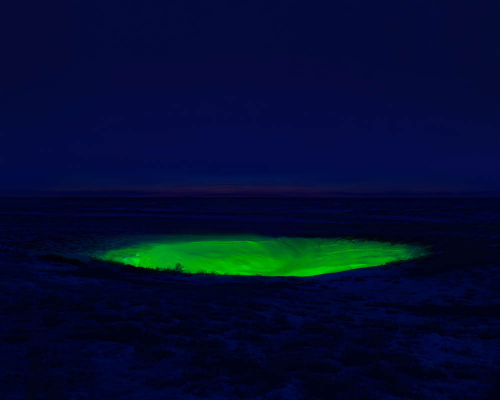
2. Crater formed after nuclear bomb test (Kazakhstan), 2019
Ever since the invention of nuclear weapons in 1945, over 2,000 nuclear explosions have been conducted on the planet.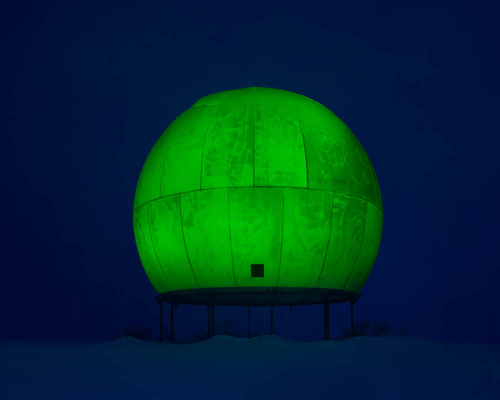
3. Abandoned radar station of the Arctic Circle (Russia), 2019
Facilities located a long way from civilisation and needing power supplies would be supplied with portable sources of power - radioisotope thermoelectric generators (RITEG) operating on radioactive isotopes (more often than not based on radioactive plutonium or strontium). Approximately one thousand such generators were manufactured in the USSR. Some of the generators were lost during transportation or subsequently abandoned, destroying and polluting the environment with radiation. Such generators are now only used to provide power for spacecraft.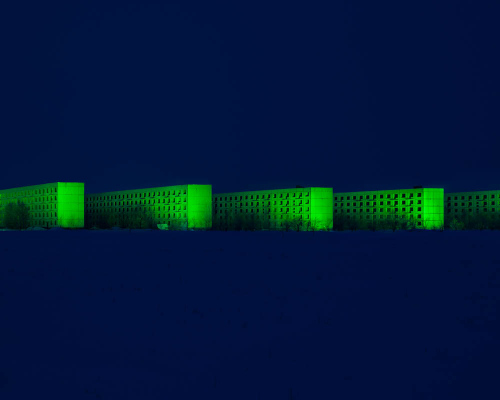
4. Radioactive city (Kazakhstan), 2019
City in the immediate proximity of a nuclear weapon testing site. The city would regularly be covered by waves of radiation as a result of nuclear tests. The number of children born with cancer and deformities increased in the city. Over time the city’s citizens acquired dosimeters and the danger became even clearer to the general public. People gradually started leaving the city until it died once and for all.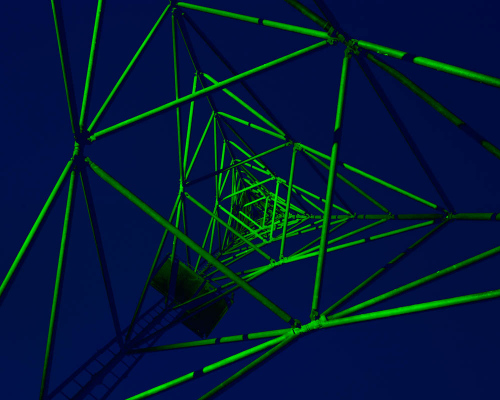
5. Duga Experimental System (Ukraine), 2019
The Duga Radar Station was created to detect the launch of inter-continental ballistic missiles. It was nicknamed the “Russian Woodpecker”, as it would cause distinctive interference (repeated “tapping’) on air all over the world. As the station required a significant amount of electricity to operate, it was built near a nuclear power plant. After the explosion of a reactor at the nuclear power plant, it was contaminated with radiation and shut down.-
1
1. Memorial to Red Army Soldier (Russia), 2019
Monument located near a military training area where a large-scale experiment was conducted. The goal of the experiment was to clarify the impact of radiation on mankind. In 1954 military exercises were organised, involving 45,000 soldiers. A RDS-2 nuclear bomb with a power of 40 kilotons was detonated nearby in the air. As a result of the exercises, thousands of its participants were exposed to various doses of radiation. In addition, 10,000 people living in adjoining population centres were affected. The strategy for a possible nuclear war was drafted on the basis of these exercises. Information on the holding of these tests was declassified in 1993. However, a number of people have still been unable to prove that they had participated in the exercises and receive compensation for their lost health owing to falsification of their personal files. -
2
2. Crater formed after nuclear bomb test (Kazakhstan), 2019
Ever since the invention of nuclear weapons in 1945, over 2,000 nuclear explosions have been conducted on the planet. -
3
3. Abandoned radar station of the Arctic Circle (Russia), 2019
Facilities located a long way from civilisation and needing power supplies would be supplied with portable sources of power - radioisotope thermoelectric generators (RITEG) operating on radioactive isotopes (more often than not based on radioactive plutonium or strontium). Approximately one thousand such generators were manufactured in the USSR. Some of the generators were lost during transportation or subsequently abandoned, destroying and polluting the environment with radiation. Such generators are now only used to provide power for spacecraft. -
4
4. Radioactive city (Kazakhstan), 2019
City in the immediate proximity of a nuclear weapon testing site. The city would regularly be covered by waves of radiation as a result of nuclear tests. The number of children born with cancer and deformities increased in the city. Over time the city’s citizens acquired dosimeters and the danger became even clearer to the general public. People gradually started leaving the city until it died once and for all. -
5
5. Duga Experimental System (Ukraine), 2019
The Duga Radar Station was created to detect the launch of inter-continental ballistic missiles. It was nicknamed the “Russian Woodpecker”, as it would cause distinctive interference (repeated “tapping’) on air all over the world. As the station required a significant amount of electricity to operate, it was built near a nuclear power plant. After the explosion of a reactor at the nuclear power plant, it was contaminated with radiation and shut down. -
6
6. Nuclear waste depository (Ukraine), 2019
The problem of storing nuclear waste arose immediately after the appearance of nuclear power. The world produces thousands of tonnes of waste a year, but has not found any way to decontaminate waste. The period of decay of certain elements takes billions of years. At present, the number of nuclear burial sites is constantly growing. -
7
7. Abandoned grain elevator (Russia), 2019
When there was an explosion at a nuclear power plant in 1986, a vast area of the crops was contaminated. Today the level of radiation at certain sites has fallen, but still remains fairly high. The local authorities take risks by growing grain on such land. -
8
8. Tunnel (Ukraine), 2019
The tunnel of an underground nuclear bunker 174 metres long, seen from below going up. Communication lines passed through the tunnel for communications with the outside world. -
9
9. Utility lines of nuclear power plant (Russia), 2019
Unfinished infrastructure components of a nuclear power plant. Construction was halted owing to a nuclear waste leak at an enterprise located nearby. -
10
10. Contaminated river (Russia), 2019
River into which radioactive waste has been dumped for more than 50 years. The river runs through a large number of population centres, where there have been perceptibly high level of cancer rates and deformities among new born babies. Some of the population centres have been abandoned. The local authorities have tried to conceal the actual contamination. -
11
11. Contaminated farm (Belarus), 2019
Contaminated farm that previously grew tomatoes. -
12
12. Stalagmite at a nuclear power plant (Ukraine), 2019
Stalagmite found by accident at one of the nuclear power plant units where the greatest nuclear disaster globally happened. As a result of human error and defects in the design of the RBMK-100 reactor, the reactor exploded in 1986, resulting in the contamination of 200,000 square kilometres of land. The total number of victims of the accident reached four million people. The radioactive cloud formed during the accident circled the whole world three times. -
13
13. Evacuated contaminated village (Ukraine), 2019
After the accident at the nuclear power plant in 1986, more than 300 villages exposed to radioactive contamination were forcibly evacuated. Their inhabitants had to start their lives all over in a new place. However, some of them decided to return home at the risk of their health. -
14
14. Ionosphere observatory (Ukraine), 2019
To create a weather-control weapon of mass destruction, scientists looked for ways to affect the ionosphere. The developers assumed that a vast antenna might be able to puncture holes in the protective shield of the atmosphere, and that as a result solar radiation could affect the natural phenomena of the territory of the opponent. -
15
15. Contaminated church (Russia), 2019
Abandoned 18th century church exposed to radiation after an accident in 1957 that occurred due to the explosion of a radioactive waste container. The contaminated area equalled 23,000 square kilometres affecting 270,000 people in 217 population centres. -
16
16. Fluorescence of radioactive mineral (Russia), 2019
Glow of uranium at a depth of 276 metres in an abandoned mine. Here the prisoners of labour camps would mine uranium, without the proper protection and safety precautions. As a rule, such prisoners would die after half a year of such work. -
17
17. Uranium mining spent mine (Russia), 2019
Uranium-235 is the most powerful nuclear fuel in the world. It is the core basis for the entire nuclear industry, nuclear weapons and nuclear power plants. Uranium is mined under the ground. Uranium mining is a dangerous production process, which brings a large number of radioactive components to the earth’s surface. -
18
18. Monument on a mountain (Russia), 2019
The monument is located in one of the most contaminated Russian regions. Radiation has been emitted intermittently by chemical enterprises. The state has tried to conceal such incidents. Approximately 4 million inhabitants of this region are regularly exposed to high levels of radiation. Cancer rates and deformities are also high among the children in the region. -
19
19. Amusement park (Ukraine), 2019
Radioactive amusement park. The park was built and fully operational, but did not manage to open owing to its proximity to a nuclear power plant where a reactor exploded. -
20
20. Chemical plant (Russia), 2019
At a nuclear waste treatment plant one of the uranium and plutonium extraction units was destroyed by an explosion in 1993. After the explosion, radioactive substances were released into the atmosphere. In total 1,940 people were exposed to radiation. -
21
21. Satan rocket (Russia), 2019
Rocket with the most powerful nuclear charge in the world and maximum range of 16,000 kilometres. A strike by dozens of these rockets would be capable of destroying 80 per cent of America’s industrial potential. They were located in mines and built so that they could even be launched after a surgical nuclear strike in the area where the rockets are located. During the Cold War, the USSR also created the Perimeter system, which guaranteed the automatic launch of a powerful retaliatory strike against the opponent, even if the country’s leaders were killed and all the country’s satellite systems were destroyed. -
22
22. Radioactive scrap metal (Kazakhstan), 2019
Equipment debris contaminated during nuclear tests. -
23
23. Installation at the site of a buried village (Ukraine), 2019
After a reactor exploded at a nuclear power plant in 1986, a vast area home to numerous population centres was contaminated. Some of the villages suffered vast doses of radiation. As a result, the authorities decided to bury radioactive buildings under the earth. I managed to ascertain the location of the buried buildings. I installed at this site powerful light projectors pointing skywards. -
24
24. Nuclear power plant (Ukraine), 2019
Unfinished power unit of a nuclear power plant with a VVER-1000 reactor. The construction site was abandoned in connection with an accident at another operational nuclear power plant. Nuclear fuel was delivered here, but was not used. The nuclear power plant was entered in the Guinness Book of Records as the most expensive unfinished nuclear power reactor in the world. -
25
25. Abandoned city (Ukraine), 2019
A reactor exploded on 26 April 1986 at 1:23 AM local time, just three kilometres away from a city with a population of 47,000 people. During the first day and a half the accident was kept classified, and nobody in the city knew about it. This decision was taken even though the level of radiation exceeded norm by tens of thousands of times. The evacuation of the city was only announced 36 hours after the accident. The inhabitants were informed that the evacuation was temporary and would only last a few days. It was proposed that they take with them from their personal belongings only documents, and leave everything else behind, including their pets. After the evacuation, they never returned home. According to certain estimates, this disaster exceeds significantly the nuclear bombing of Hiroshima in terms of the number of victims. Today the city has been completely looted. Marauders have embezzled all available contaminated valuables and metal. -
26
26. Ship (Ukraine), 2019
Ship contaminated with radiation 30 years ago owing to the explosion of a reactor at the nearest nuclear power plant. -
27
27. Radioactive mountain (Russia), 2019
The production of radioactive uranium generates a vast amount of radioactive waste. One tonne of radioactive ore is required to produce 2 kilograms of uranium. As a result, entire radioactive mountains grow near the production facility. -
28
28. Secret hideout (Russia), 2019
A military bomber equipped with nuclear warheads was located in this concealed hangar. -
29
29. Rail car of the liquidators (Ukraine), 2019
One of the rail cars used to transport the people tasked with cleaning up the consequences of the explosion of a reactor at a nuclear power plant in 1986. They had to work in the harshest radioactive conditions. Most of them were unable to assess the risks that they assumed, as the level of radiation was not disclosed. According to some estimates, 25,000 liquidators died and 70,000 became disabled. The total number of liquidators is unknown – according to some sources there were 1,000,000. -
30
30. Monument to the victims of radiation disasters (Russia), 2019
Monument to the victims of radiation disasters. The monument was installed in a contaminated region.

1. Memorial to Red Army Soldier (Russia), 2019
Monument located near a military training area where a large-scale experiment was conducted. The goal of the experiment was to clarify the impact of radiation on mankind. In 1954 military exercises were organised, involving 45,000 soldiers. A RDS-2 nuclear bomb with a power of 40 kilotons was detonated nearby in the air. As a result of the exercises, thousands of its participants were exposed to various doses of radiation. In addition, 10,000 people living in adjoining population centres were affected. The strategy for a possible nuclear war was drafted on the basis of these exercises. Information on the holding of these tests was declassified in 1993. However, a number of people have still been unable to prove that they had participated in the exercises and receive compensation for their lost health owing to falsification of their personal files.
2. Crater formed after nuclear bomb test (Kazakhstan), 2019
Ever since the invention of nuclear weapons in 1945, over 2,000 nuclear explosions have been conducted on the planet.
3. Abandoned radar station of the Arctic Circle (Russia), 2019
Facilities located a long way from civilisation and needing power supplies would be supplied with portable sources of power - radioisotope thermoelectric generators (RITEG) operating on radioactive isotopes (more often than not based on radioactive plutonium or strontium). Approximately one thousand such generators were manufactured in the USSR. Some of the generators were lost during transportation or subsequently abandoned, destroying and polluting the environment with radiation. Such generators are now only used to provide power for spacecraft.
4. Radioactive city (Kazakhstan), 2019
City in the immediate proximity of a nuclear weapon testing site. The city would regularly be covered by waves of radiation as a result of nuclear tests. The number of children born with cancer and deformities increased in the city. Over time the city’s citizens acquired dosimeters and the danger became even clearer to the general public. People gradually started leaving the city until it died once and for all.
5. Duga Experimental System (Ukraine), 2019
The Duga Radar Station was created to detect the launch of inter-continental ballistic missiles. It was nicknamed the “Russian Woodpecker”, as it would cause distinctive interference (repeated “tapping’) on air all over the world. As the station required a significant amount of electricity to operate, it was built near a nuclear power plant. After the explosion of a reactor at the nuclear power plant, it was contaminated with radiation and shut down.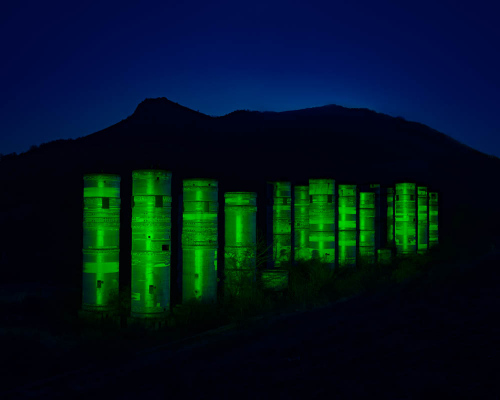
6. Nuclear waste depository (Ukraine), 2019
The problem of storing nuclear waste arose immediately after the appearance of nuclear power. The world produces thousands of tonnes of waste a year, but has not found any way to decontaminate waste. The period of decay of certain elements takes billions of years. At present, the number of nuclear burial sites is constantly growing.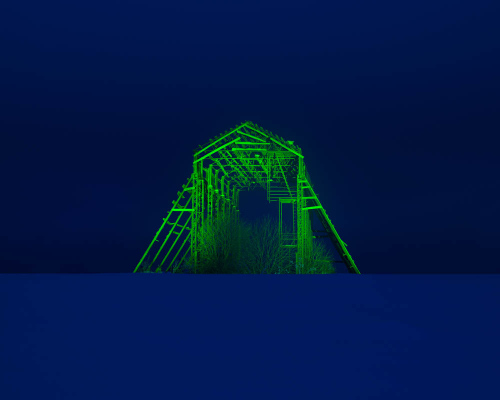
7. Abandoned grain elevator (Russia), 2019
When there was an explosion at a nuclear power plant in 1986, a vast area of the crops was contaminated. Today the level of radiation at certain sites has fallen, but still remains fairly high. The local authorities take risks by growing grain on such land.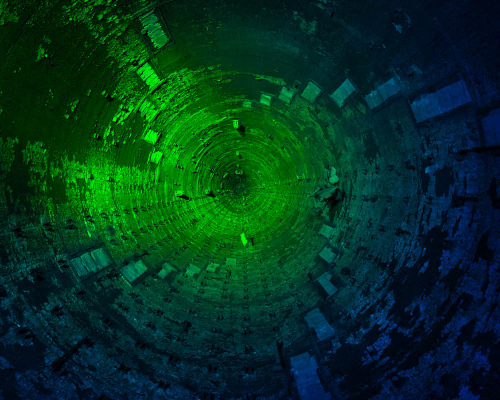
8. Tunnel (Ukraine), 2019
The tunnel of an underground nuclear bunker 174 metres long, seen from below going up. Communication lines passed through the tunnel for communications with the outside world.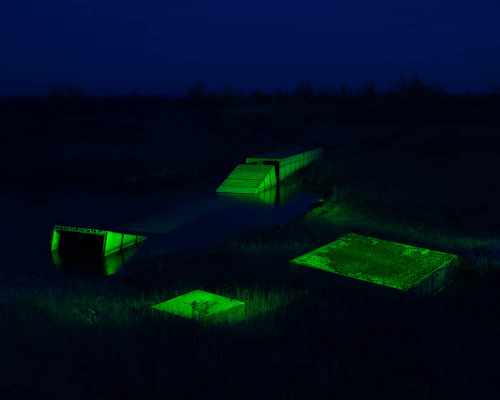
9. Utility lines of nuclear power plant (Russia), 2019
Unfinished infrastructure components of a nuclear power plant. Construction was halted owing to a nuclear waste leak at an enterprise located nearby.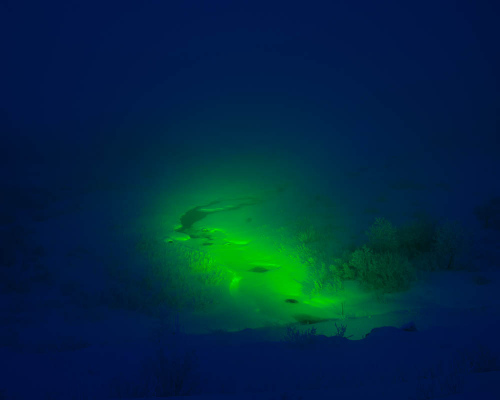
10. Contaminated river (Russia), 2019
River into which radioactive waste has been dumped for more than 50 years. The river runs through a large number of population centres, where there have been perceptibly high level of cancer rates and deformities among new born babies. Some of the population centres have been abandoned. The local authorities have tried to conceal the actual contamination.
11. Contaminated farm (Belarus), 2019
Contaminated farm that previously grew tomatoes.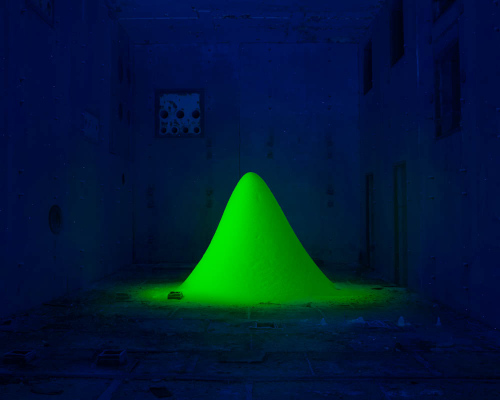
12. Stalagmite at a nuclear power plant (Ukraine), 2019
Stalagmite found by accident at one of the nuclear power plant units where the greatest nuclear disaster globally happened. As a result of human error and defects in the design of the RBMK-100 reactor, the reactor exploded in 1986, resulting in the contamination of 200,000 square kilometres of land. The total number of victims of the accident reached four million people. The radioactive cloud formed during the accident circled the whole world three times.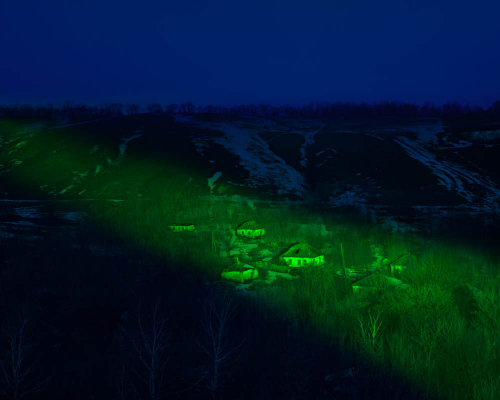
13. Evacuated contaminated village (Ukraine), 2019
After the accident at the nuclear power plant in 1986, more than 300 villages exposed to radioactive contamination were forcibly evacuated. Their inhabitants had to start their lives all over in a new place. However, some of them decided to return home at the risk of their health.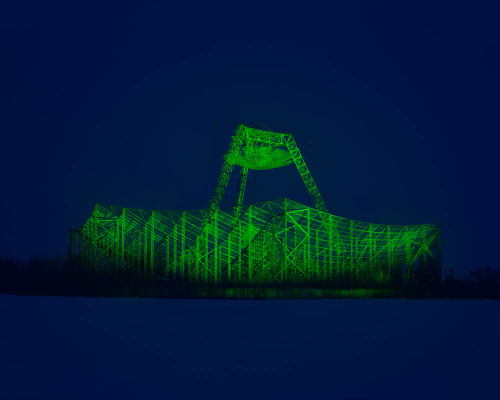
14. Ionosphere observatory (Ukraine), 2019
To create a weather-control weapon of mass destruction, scientists looked for ways to affect the ionosphere. The developers assumed that a vast antenna might be able to puncture holes in the protective shield of the atmosphere, and that as a result solar radiation could affect the natural phenomena of the territory of the opponent.
15. Contaminated church (Russia), 2019
Abandoned 18th century church exposed to radiation after an accident in 1957 that occurred due to the explosion of a radioactive waste container. The contaminated area equalled 23,000 square kilometres affecting 270,000 people in 217 population centres.
16. Fluorescence of radioactive mineral (Russia), 2019
Glow of uranium at a depth of 276 metres in an abandoned mine. Here the prisoners of labour camps would mine uranium, without the proper protection and safety precautions. As a rule, such prisoners would die after half a year of such work.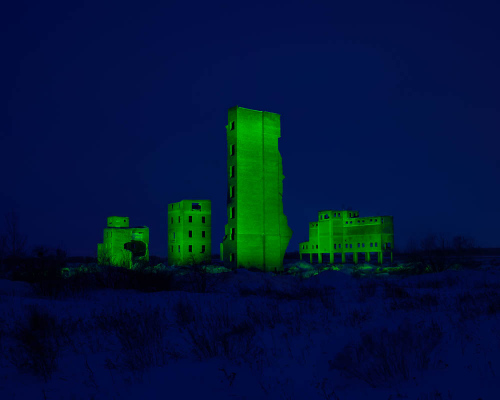
17. Uranium mining spent mine (Russia), 2019
Uranium-235 is the most powerful nuclear fuel in the world. It is the core basis for the entire nuclear industry, nuclear weapons and nuclear power plants. Uranium is mined under the ground. Uranium mining is a dangerous production process, which brings a large number of radioactive components to the earth’s surface.
18. Monument on a mountain (Russia), 2019
The monument is located in one of the most contaminated Russian regions. Radiation has been emitted intermittently by chemical enterprises. The state has tried to conceal such incidents. Approximately 4 million inhabitants of this region are regularly exposed to high levels of radiation. Cancer rates and deformities are also high among the children in the region.
19. Amusement park (Ukraine), 2019
Radioactive amusement park. The park was built and fully operational, but did not manage to open owing to its proximity to a nuclear power plant where a reactor exploded.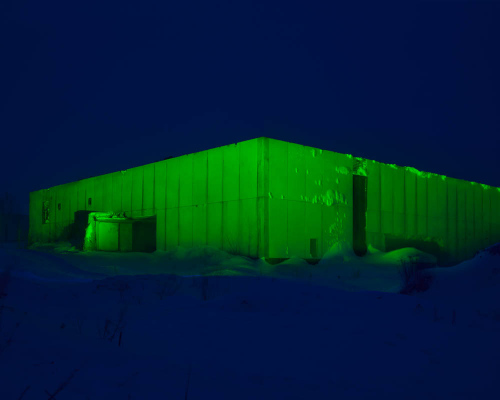
20. Chemical plant (Russia), 2019
At a nuclear waste treatment plant one of the uranium and plutonium extraction units was destroyed by an explosion in 1993. After the explosion, radioactive substances were released into the atmosphere. In total 1,940 people were exposed to radiation.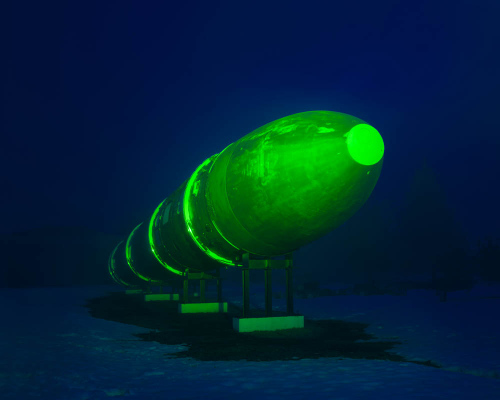
21. Satan rocket (Russia), 2019
Rocket with the most powerful nuclear charge in the world and maximum range of 16,000 kilometres. A strike by dozens of these rockets would be capable of destroying 80 per cent of America’s industrial potential. They were located in mines and built so that they could even be launched after a surgical nuclear strike in the area where the rockets are located. During the Cold War, the USSR also created the Perimeter system, which guaranteed the automatic launch of a powerful retaliatory strike against the opponent, even if the country’s leaders were killed and all the country’s satellite systems were destroyed.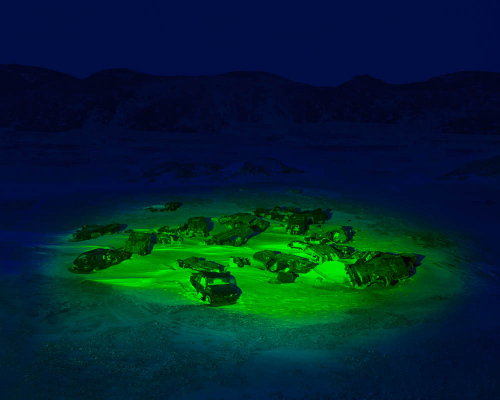
22. Radioactive scrap metal (Kazakhstan), 2019
Equipment debris contaminated during nuclear tests.
23. Installation at the site of a buried village (Ukraine), 2019
After a reactor exploded at a nuclear power plant in 1986, a vast area home to numerous population centres was contaminated. Some of the villages suffered vast doses of radiation. As a result, the authorities decided to bury radioactive buildings under the earth. I managed to ascertain the location of the buried buildings. I installed at this site powerful light projectors pointing skywards.
24. Nuclear power plant (Ukraine), 2019
Unfinished power unit of a nuclear power plant with a VVER-1000 reactor. The construction site was abandoned in connection with an accident at another operational nuclear power plant. Nuclear fuel was delivered here, but was not used. The nuclear power plant was entered in the Guinness Book of Records as the most expensive unfinished nuclear power reactor in the world.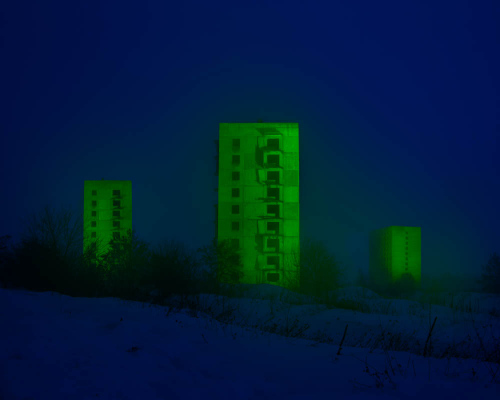
25. Abandoned city (Ukraine), 2019
A reactor exploded on 26 April 1986 at 1:23 AM local time, just three kilometres away from a city with a population of 47,000 people. During the first day and a half the accident was kept classified, and nobody in the city knew about it. This decision was taken even though the level of radiation exceeded norm by tens of thousands of times. The evacuation of the city was only announced 36 hours after the accident. The inhabitants were informed that the evacuation was temporary and would only last a few days. It was proposed that they take with them from their personal belongings only documents, and leave everything else behind, including their pets. After the evacuation, they never returned home. According to certain estimates, this disaster exceeds significantly the nuclear bombing of Hiroshima in terms of the number of victims. Today the city has been completely looted. Marauders have embezzled all available contaminated valuables and metal.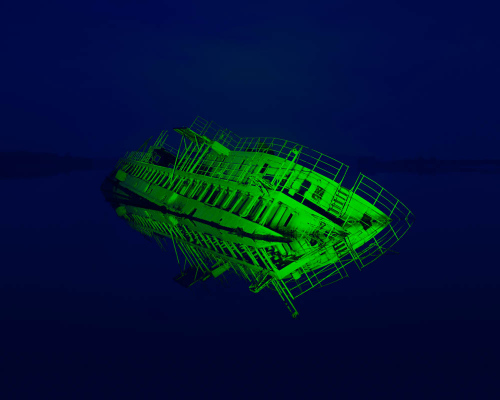
26. Ship (Ukraine), 2019
Ship contaminated with radiation 30 years ago owing to the explosion of a reactor at the nearest nuclear power plant.
27. Radioactive mountain (Russia), 2019
The production of radioactive uranium generates a vast amount of radioactive waste. One tonne of radioactive ore is required to produce 2 kilograms of uranium. As a result, entire radioactive mountains grow near the production facility.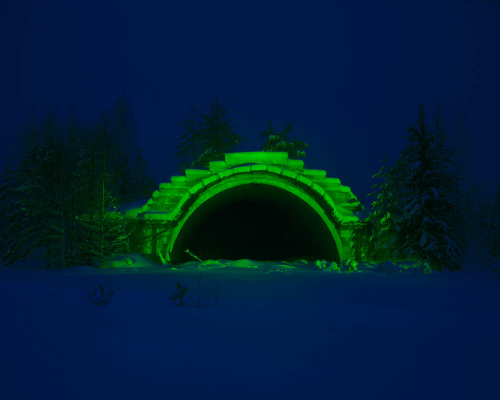
28. Secret hideout (Russia), 2019
A military bomber equipped with nuclear warheads was located in this concealed hangar.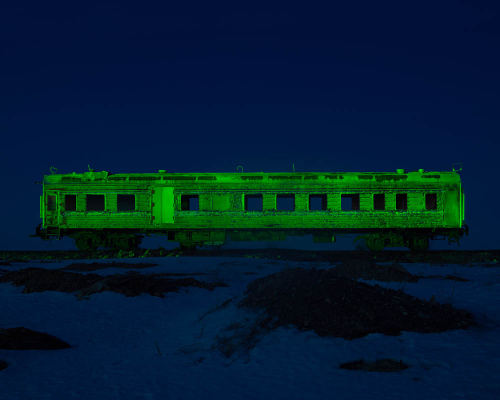
29. Rail car of the liquidators (Ukraine), 2019
One of the rail cars used to transport the people tasked with cleaning up the consequences of the explosion of a reactor at a nuclear power plant in 1986. They had to work in the harshest radioactive conditions. Most of them were unable to assess the risks that they assumed, as the level of radiation was not disclosed. According to some estimates, 25,000 liquidators died and 70,000 became disabled. The total number of liquidators is unknown – according to some sources there were 1,000,000.
30. Monument to the victims of radiation disasters (Russia), 2019
Monument to the victims of radiation disasters. The monument was installed in a contaminated region.-
1
1. Memorial to Red Army Soldier (Russia), 2019
Monument located near a military training area where a large-scale experiment was conducted. The goal of the experiment was to clarify the impact of radiation on mankind. In 1954 military exercises were organised, involving 45,000 soldiers. A RDS-2 nuclear bomb with a power of 40 kilotons was detonated nearby in the air. As a result of the exercises, thousands of its participants were exposed to various doses of radiation. In addition, 10,000 people living in adjoining population centres were affected. The strategy for a possible nuclear war was drafted on the basis of these exercises. Information on the holding of these tests was declassified in 1993. However, a number of people have still been unable to prove that they had participated in the exercises and receive compensation for their lost health owing to falsification of their personal files. -
2
2. Crater formed after nuclear bomb test (Kazakhstan), 2019
Ever since the invention of nuclear weapons in 1945, over 2,000 nuclear explosions have been conducted on the planet. -
3
3. Abandoned radar station of the Arctic Circle (Russia), 2019
Facilities located a long way from civilisation and needing power supplies would be supplied with portable sources of power - radioisotope thermoelectric generators (RITEG) operating on radioactive isotopes (more often than not based on radioactive plutonium or strontium). Approximately one thousand such generators were manufactured in the USSR. Some of the generators were lost during transportation or subsequently abandoned, destroying and polluting the environment with radiation. Such generators are now only used to provide power for spacecraft. -
4
4. Radioactive city (Kazakhstan), 2019
City in the immediate proximity of a nuclear weapon testing site. The city would regularly be covered by waves of radiation as a result of nuclear tests. The number of children born with cancer and deformities increased in the city. Over time the city’s citizens acquired dosimeters and the danger became even clearer to the general public. People gradually started leaving the city until it died once and for all. -
5
5. Duga Experimental System (Ukraine), 2019
The Duga Radar Station was created to detect the launch of inter-continental ballistic missiles. It was nicknamed the “Russian Woodpecker”, as it would cause distinctive interference (repeated “tapping’) on air all over the world. As the station required a significant amount of electricity to operate, it was built near a nuclear power plant. After the explosion of a reactor at the nuclear power plant, it was contaminated with radiation and shut down. -
6
6. Nuclear waste depository (Ukraine), 2019
The problem of storing nuclear waste arose immediately after the appearance of nuclear power. The world produces thousands of tonnes of waste a year, but has not found any way to decontaminate waste. The period of decay of certain elements takes billions of years. At present, the number of nuclear burial sites is constantly growing. -
7
7. Abandoned grain elevator (Russia), 2019
When there was an explosion at a nuclear power plant in 1986, a vast area of the crops was contaminated. Today the level of radiation at certain sites has fallen, but still remains fairly high. The local authorities take risks by growing grain on such land. -
8
8. Tunnel (Ukraine), 2019
The tunnel of an underground nuclear bunker 174 metres long, seen from below going up. Communication lines passed through the tunnel for communications with the outside world. -
9
9. Utility lines of nuclear power plant (Russia), 2019
Unfinished infrastructure components of a nuclear power plant. Construction was halted owing to a nuclear waste leak at an enterprise located nearby. -
10
10. Contaminated river (Russia), 2019
River into which radioactive waste has been dumped for more than 50 years. The river runs through a large number of population centres, where there have been perceptibly high level of cancer rates and deformities among new born babies. Some of the population centres have been abandoned. The local authorities have tried to conceal the actual contamination. -
11
11. Contaminated farm (Belarus), 2019
Contaminated farm that previously grew tomatoes. -
12
12. Stalagmite at a nuclear power plant (Ukraine), 2019
Stalagmite found by accident at one of the nuclear power plant units where the greatest nuclear disaster globally happened. As a result of human error and defects in the design of the RBMK-100 reactor, the reactor exploded in 1986, resulting in the contamination of 200,000 square kilometres of land. The total number of victims of the accident reached four million people. The radioactive cloud formed during the accident circled the whole world three times. -
13
13. Evacuated contaminated village (Ukraine), 2019
After the accident at the nuclear power plant in 1986, more than 300 villages exposed to radioactive contamination were forcibly evacuated. Their inhabitants had to start their lives all over in a new place. However, some of them decided to return home at the risk of their health. -
14
14. Ionosphere observatory (Ukraine), 2019
To create a weather-control weapon of mass destruction, scientists looked for ways to affect the ionosphere. The developers assumed that a vast antenna might be able to puncture holes in the protective shield of the atmosphere, and that as a result solar radiation could affect the natural phenomena of the territory of the opponent. -
15
15. Contaminated church (Russia), 2019
Abandoned 18th century church exposed to radiation after an accident in 1957 that occurred due to the explosion of a radioactive waste container. The contaminated area equalled 23,000 square kilometres affecting 270,000 people in 217 population centres. -
16
16. Fluorescence of radioactive mineral (Russia), 2019
Glow of uranium at a depth of 276 metres in an abandoned mine. Here the prisoners of labour camps would mine uranium, without the proper protection and safety precautions. As a rule, such prisoners would die after half a year of such work. -
17
17. Uranium mining spent mine (Russia), 2019
Uranium-235 is the most powerful nuclear fuel in the world. It is the core basis for the entire nuclear industry, nuclear weapons and nuclear power plants. Uranium is mined under the ground. Uranium mining is a dangerous production process, which brings a large number of radioactive components to the earth’s surface. -
18
18. Monument on a mountain (Russia), 2019
The monument is located in one of the most contaminated Russian regions. Radiation has been emitted intermittently by chemical enterprises. The state has tried to conceal such incidents. Approximately 4 million inhabitants of this region are regularly exposed to high levels of radiation. Cancer rates and deformities are also high among the children in the region. -
19
19. Amusement park (Ukraine), 2019
Radioactive amusement park. The park was built and fully operational, but did not manage to open owing to its proximity to a nuclear power plant where a reactor exploded. -
20
20. Chemical plant (Russia), 2019
At a nuclear waste treatment plant one of the uranium and plutonium extraction units was destroyed by an explosion in 1993. After the explosion, radioactive substances were released into the atmosphere. In total 1,940 people were exposed to radiation. -
21
21. Satan rocket (Russia), 2019
Rocket with the most powerful nuclear charge in the world and maximum range of 16,000 kilometres. A strike by dozens of these rockets would be capable of destroying 80 per cent of America’s industrial potential. They were located in mines and built so that they could even be launched after a surgical nuclear strike in the area where the rockets are located. During the Cold War, the USSR also created the Perimeter system, which guaranteed the automatic launch of a powerful retaliatory strike against the opponent, even if the country’s leaders were killed and all the country’s satellite systems were destroyed. -
22
22. Radioactive scrap metal (Kazakhstan), 2019
Equipment debris contaminated during nuclear tests. -
23
23. Installation at the site of a buried village (Ukraine), 2019
After a reactor exploded at a nuclear power plant in 1986, a vast area home to numerous population centres was contaminated. Some of the villages suffered vast doses of radiation. As a result, the authorities decided to bury radioactive buildings under the earth. I managed to ascertain the location of the buried buildings. I installed at this site powerful light projectors pointing skywards. -
24
24. Nuclear power plant (Ukraine), 2019
Unfinished power unit of a nuclear power plant with a VVER-1000 reactor. The construction site was abandoned in connection with an accident at another operational nuclear power plant. Nuclear fuel was delivered here, but was not used. The nuclear power plant was entered in the Guinness Book of Records as the most expensive unfinished nuclear power reactor in the world. -
25
25. Abandoned city (Ukraine), 2019
A reactor exploded on 26 April 1986 at 1:23 AM local time, just three kilometres away from a city with a population of 47,000 people. During the first day and a half the accident was kept classified, and nobody in the city knew about it. This decision was taken even though the level of radiation exceeded norm by tens of thousands of times. The evacuation of the city was only announced 36 hours after the accident. The inhabitants were informed that the evacuation was temporary and would only last a few days. It was proposed that they take with them from their personal belongings only documents, and leave everything else behind, including their pets. After the evacuation, they never returned home. According to certain estimates, this disaster exceeds significantly the nuclear bombing of Hiroshima in terms of the number of victims. Today the city has been completely looted. Marauders have embezzled all available contaminated valuables and metal. -
26
26. Ship (Ukraine), 2019
Ship contaminated with radiation 30 years ago owing to the explosion of a reactor at the nearest nuclear power plant. -
27
27. Radioactive mountain (Russia), 2019
The production of radioactive uranium generates a vast amount of radioactive waste. One tonne of radioactive ore is required to produce 2 kilograms of uranium. As a result, entire radioactive mountains grow near the production facility. -
28
28. Secret hideout (Russia), 2019
A military bomber equipped with nuclear warheads was located in this concealed hangar. -
29
29. Rail car of the liquidators (Ukraine), 2019
One of the rail cars used to transport the people tasked with cleaning up the consequences of the explosion of a reactor at a nuclear power plant in 1986. They had to work in the harshest radioactive conditions. Most of them were unable to assess the risks that they assumed, as the level of radiation was not disclosed. According to some estimates, 25,000 liquidators died and 70,000 became disabled. The total number of liquidators is unknown – according to some sources there were 1,000,000. -
30
30. Monument to the victims of radiation disasters (Russia), 2019
Monument to the victims of radiation disasters. The monument was installed in a contaminated region.
ACID
Danila Tkachenko
Today mankind is surrounded by a number of invisible threats capable of causing significant damage to the human body or fully destroying it. Air pollution, viruses, radiation – while they cannot be seen or felt when we are exposed to them, at the same time they are capable of having a considerable impact on the environment and transforming it.
I use projectors with a green filter to expose and identify places contaminated by radiation. The additional element in the form of a splash of colour on the light destroys the formal photographic look, representing an invisible threat, and thereby rendering the image more realistic.
The acidic colour is frequently used to portray toxicity in mass culture. It is representative of part of the public’s fantasy about disaster and has little in common with forms of toxic pollution, as the latter are invisible.
One of the most important functions of fantasy is the aspect of psychological defence: repression, regression and denial.
This protective mechanism kicks in when we come into contact with apocalyptic content, as we convince ourselves that a global catastrophe is intrinsically unreal, while a manmade threat or mysophobia represents merely remote possibilities and projections from the here and now.
The fantasy of disaster consequently demonstrates that we don’t believe in disaster. However, it represents specifically one way in which we perceive the world.
By making the fictional representation clash with actual pollution, I try to return to the real world from the imaginary plane.
-
1
Danila Tkachenko ©